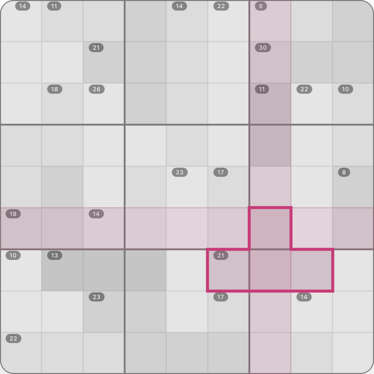These strategies can help you approach Killer Sudoku puzzles efficiently, leading to logical deductions and a smoother solving experience.
Cages or Killer Groups
A killer group is a cohesive group of cells. These groups are independent of other structures on the Sudoku board and can span multiple boxes.
Groups do not contain duplicate numbers. Depending on the level of difficulty, they contain between 2 and 5 cells.
Clicking on a cell highlights the group it is in.
For each group, the sum of its individual numbers is known. In addition, Killer Sudokus contain no or only a few specifications, depending on the situation.
Example: In a Killer group with three cells whose sum is 6, only the numbers 1, 2, and 3 are located. All other additions would not result in 6.
In addition, with a killer group it can be assumed that for the area that lies within the same box, the total sum of all the numbers already revealed, the cells that belong to the group and the other cells cannot exceed the value of all cells in the box (in the case of a 3x3 box the sum is 45). This may allow assumptions to be made about the possible value of the cells located in another box.
Cages or Killer Groups
A killer group is a cohesive group of cells. These groups are independent of other structures on the Sudoku board and can span multiple boxes.
Groups do not contain duplicate numbers. Depending on the level of difficulty, they contain between 2 and 5 cells.
Clicking on a cell highlights the group it is in.
For each group, the sum of its individual numbers is known. In addition, Killer Sudokus contain no or only a few specifications, depending on the situation.
Example: In a Killer group with three cells whose sum is 6, only the numbers 1, 2, and 3 are located. All other additions would not result in 6.
In addition, with a killer group it can be assumed that for the area that lies within the same box, the total sum of all the numbers already revealed, the cells that belong to the group and the other cells cannot exceed the value of all cells in the box (in the case of a 3x3 box the sum is 45). This may allow assumptions to be made about the possible value of the cells located in another box.



